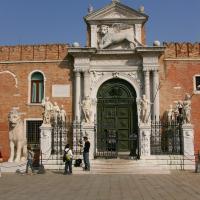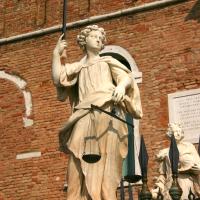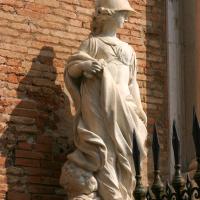Overview
Arsenale is a corruption of the Arabic word, “darisina," meaning house of industry. It was the military shipyard of the Venetian Republic, initially built on twin isles and continuously expanded until the 17th century. Located in the Northeastern section of the city, the surrounding neighborhood (or seistere in Venetian) of the Castello traditionally housed the Arsenale's workers. At maximum activity 16,000 men worked there, and could turn out a fully rigged and kitted war galleon in less than a day. Dante describes the Arsenale of Venice in Canto XXI of his Inferno.
The main gate, or Porta Magna, was erected in 1460 by Doge Pasquale Malipiero. After the naval victory over the Ottomans at Lepanto (1571), the gate was turned into a commemorative monument by adding two winged victories. In 1682, a terrace was added and eight allegorical gods and goddesses were placed on balustrade.
The lions arrived from Athens in 1687, sent by Francesco Morosini as war booty. The left lion is from Piraeus, the Athenian port, and has runic inscriptions on its shoulder and side, which were carved by the Viking Varengian guard of the Byzantine emperor during a Greek uprising. The right lion was created by the school of Naxos, probably in the 4th century BCE.
- Lorenzetti, Venice and Its Lagoon: Historical-Artistic Guide (Rome: Istituto Poligrafico dello Stato, 1961) as translated and with supplementary content by Taryn Marie Zarrillo, 2012/13











































